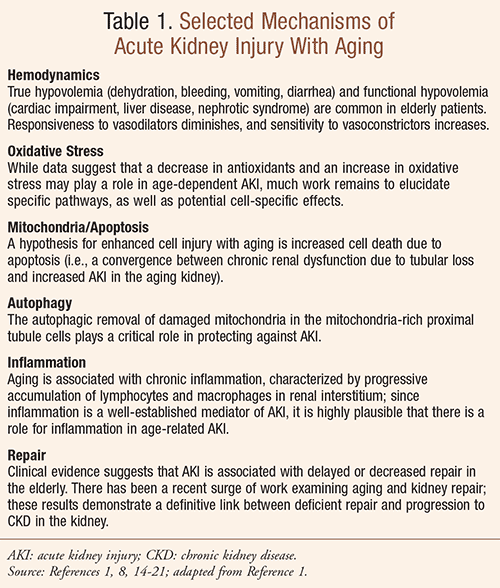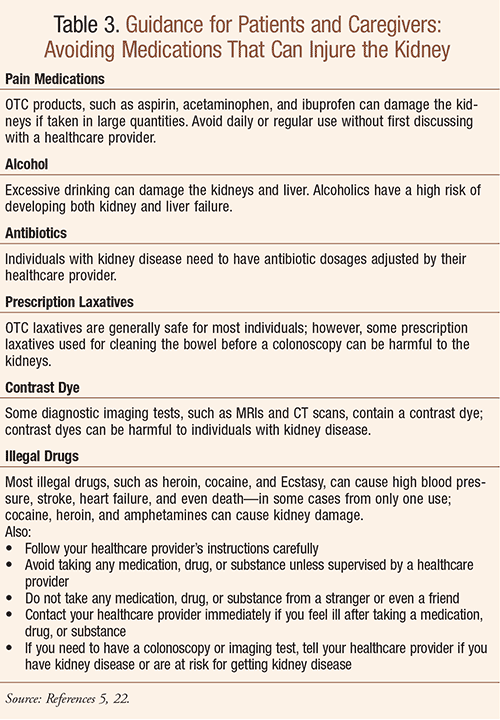US Pharm. 2016;41(8)7-9.
Patient self-medicating for pain relief has always been a variable to consider when a medication regimen is reviewed. However, the present “opioid epidemic” and cautions about opioid prescribing should heighten awareness of the risks that can ensue when patients use analgesics without the advantage of physician and/or pharmacist monitoring—whether the medications are OTC pain relievers or shared prescription analgesics prescribed for others. Patient advocacy, education, and communication on the subject of keeping kidneys healthy need to be addressed as they relate to analgesic use in older adults—now more than ever.
Renal Aging: Multiple Mechanisms
Aging of the kidneys is a multifactorial process. While an increased, complex susceptibility to renal injury occurs with age, the ability of the kidney to repair itself diminishes.1 Research findings indicate that many mechanisms (TABLE 1) are at play regarding these multiple pathways affecting renal aging.1 Importantly, renal aging predisposes the older adult population to acute kidney injury (AKI), previously called acute renal failure (ARF).1,2

NSAIDs: Actions on the Kidney
The renal effect of nonsteroidal anti-inflammatory drugs (NSAIDs) is the inhibition of prostaglandin (PG) synthesis, specifically PGE2 and PGI2. These prostaglandins are responsible for maintaining renal blood flow; thus, decreasing their synthesis can result in sodium and water retention and may cause edema in some people; those with a history of heart failure or kidney disease are at particularly high risk.3 With regard to drug-drug interactions, the renal effects of NSAIDs can mitigate the beneficial effects of antihypertensive medications.3
The elderly are a high-risk population for adverse effects from NSAIDs.4 Owing to the above-mentioned adverse effects, if use cannot be avoided, it is preferable to use NSAIDs at the lowest effective dose for the shortest possible duration.3 Furthermore, in the elderly, compromise of existing renal function can occur, especially when creatinine clearance (CrCl) is 30 mL/min.4
Guiding Patients Taking Daily Aspirin
When taken as directed, regular use of aspirin does not seem to increase the risk of kidney disease in people who have normal renal function.5 Patients should be counseled that with regard to kidney injury, there is no evidence of risk with the regular use of aspirin in the lower doses recommended for prevention of heart attacks.5 According to the National Kidney Foundation’s guidance to patients, “use of a ‘baby aspirin’ (81 to 162 mg per day) daily is fine, even with reduced kidney function.”5 In renal impairment with CrCl <10 mL/min, aspirin should be avoided.4
Of note, doses that are too high (typically more than 6 or 8 tablets a day) may temporarily, and possibly permanently, reduce renal function.5 The geriatric and adult analgesic oral dose of aspirin—325 to 650 mg (rectal dose, 300 to 600 mg) every 4-6 hours up to 4 g/day—falls into this category.4 Reports of increased blood urea nitrogen, increased serum creatinine, interstitial nephritis, renal failure (including cases caused by rhabdomyolysis), renal insufficiency, and renal papillary necrosis have all been associated with the use of aspirin.4 Additionally, patients need to be informed that in individuals with kidney disease, aspirin may increase the tendency to bleed.5 Guiding patients with renal impairment or other comorbidities such as liver disease or severe heart failure not to use aspirin without speaking with their healthcare provider is essential.5
The Omnipresence of Acetaminophen
Acetaminophen is currently found in many dual- and multi-ingredient formulations available OTC and by prescription, such that it is almost omnipresent in medication regimens across the U.S. Patients need to be informed that acetaminophen, which may be a component of combination products, can cause duplicate-therapy issues. Older patients—who may have been taking acetaminophen for decades—should be counseled regarding the reduced maximum doses established in 2011 and the increased dosing interval regarding some acetaminophen OTC products.4 Patients with a CrCl of 10-50 mL/min should administer the drug every 6 hours, while those with a CrCl of <10 mL/min should administer it every 8 hours.4 Caution is advised with the combined use of aspirin and acetaminophen. Prolonged concurrent use of aspirin and acetaminophen should be avoided, as this combination may increase the risk of analgesic-associated nephropathy.6
Analgesic Nephropathy
Analgesic nephropathy (AN) is a type of chronic tubulointerstitial nephritis secondary to a cumulative lifetime use of large amounts (e.g., 2 kg) of certain analgesics.7 This condition occurs more often in women, with a peak incidence between ages 50 and 55 years, and is responsible for 3% to 5% of cases of end-stage renal disease in the United States, and for 13% to 20% in Australia and South Africa.7 Patients present with kidney injury; signs and symptoms are outlined in TABLE 2. Patients with AN develop hypertension, anemia, and an impaired ability to concentrate urine; papillary necrosis occurs late in the course.7
While originally described in association with overuse of combination analgesic agents containing phenacetin (typically with aspirin, acetaminophen, codeine, or caffeine), removal of phenacetin from the market did not stop AN from occurring.7 Acetaminophen, aspirin, and other NSAIDs have been implicated, although studies to identify the causal agent are equivocal; the mechanism of AN remains unclear.7 It is not known whether cyclooxygenase 2 (COX-2) inhibitors cause AN; however, these agents probably can cause acute tubulointerstitial nephritis and nephrotic syndrome due to minimal change disease or membranous nephropathy.7 AN is diagnosed based on a history of analgesic use and the results of noncontrast computed tomography (CT). Treatment consists of stopping the causative analgesic, which results in stabilized renal function unless kidney injury is advanced, in which case it may progress to CKD. Patients with AN are at greater risk of transitional cell carcinomas of the urinary tract.7 For a comprehensive overview of the special geriatric considerations regarding the use and dosage of acetaminophen, aspirin, and other NSAIDs in the elderly, refer to Reference 4.
Contrast Media Use on the Rise
The aging kidney has diminished responsiveness to vasodilators and increased sensitivity to vasoconstrictors.8 Prolonged vasoconstriction secondary to contrast media administration is associated with acute renal dysfunction in elderly patients.9 Data suggest that the normal vascular response is impaired in the aging kidney, and this contributes to the increased AKI.1 While age may not be an independent predictor of contrast-induced nephropathy (CIN), CIN is a significant cause of AKI in hospitalized elderly patients.9,10,11 Many expect CIN will remain an important cause of AKI in older adults owing to the increased use of contrast media in this population.12 For information regarding reducing the risk for CIN and nephrogenic systemic fibrosis (NSF), refer to Reference 13.
Monitoring and Counseling Patients
Patients should be informed that while being treated with an analgesic, laboratory monitoring for safety may be necessary, including serum creatinine, glomerular filtration rate, and urine protein; persistent protein in the urine may be an early indication of kidney damage.5 A provider-patient contract-of-understanding regarding the use of analgesics for pain and comfort should address the patient’s responsibility in participating in the safe administration and monitoring of these agents; such a contract is an integral part of a comprehensive plan to develop tailored, individualized therapeutic outcomes. TABLE 3 can assist in providing guidance to geriatric patients and their caregivers with regard to avoiding medications that can injure the kidney. Underscoring the importance of following the healthcare provider’s instructions and avoiding the use of illegal substances are additional tips for keeping kidneys healthy.

Conclusion
Proactively guiding older patients and their caregivers with advice for keeping kidneys healthy when using OTC analgesics—and the avoidance of other medications that may injure the kidneys— facilitates the opportunity for preservation of patients’ vital organs, as well as overall medication tolerability and safety.
REFERENCES
1. Wang X, Bonventre JV, Parrish AR. The aging kidney: increased susceptibility to nephrotoxicity. Int J Mol Sci. 2014;15(9):15358-15376.
2. Webb S, Dobb G. Arf, atn or aki? It’s now acute kidney injury. Anaesth Intensive Care. 2007;35:843-844.
3. Dietrich E, Carris N, Panavelil TA. Anti-inflammatory, antipyretic, and analgesic agents. In: Whalen K, ed. Pharmacology. 6th ed. Philadelphia, PA: Wolters Kluwer; 2015:365-373.
4. Semla TP, Beizer JL, Higbee MD. Geriatric Dosage Handbook. 20th ed. Hudson, OH: Lexicomp; 2015:25-28,115-119,1007-1010.
5. National Kidney Foundation. Pain medicines (analgesics). 2016. www.kidney.org/atoz/content/painMeds_Analgesics. Accessed July 5, 2016.
6. Epocrates.com. Epocrates Plus Version 15.12.1. Updated June 23, 2016.
7. Analgesic nephropathy. Merckmanuals.com. Last full review/revision January 2016. www.merckmanuals.com/professional/genitourinary-disorders/tubulointerstitial-diseases/analgesic-nephropathy. Accessed July 11, 2016.
8. Jerkic M, Vojvodic S, López-Novoa JM. The mechanism of increased renal susceptibility to toxic substances in the elderly. Part 1. The role of increased vasoconstriction. Int Urol Nephrol 2001;32:539-547.
9. Rich MW, Crecelius CA. Incidence, risk factors, and clinical course of acute renal insufficiency after cardiac catheterization in patients 70 years of age or older. A prospective study. Arch Intern Med. 1990;150:1237-1242.
10. McGillicuddy EA, Schuster KM, Kaplan LJ, et al. Contrast-induced nephropathy in elderly trauma patients. J Trauma. 2010;68:294-297.
11. Kohli HS, Bhaskaran MC, Muthukumar T, et al. Treatment-related acute renal failure in the elderly: a hospital-based prospective study. Nephrol Dial Transplant. 2000;15:212-217.
12. Rudnick MR, Goldfarb S, Tumlin J. Contrast-induced nephropathy: is the picture any clearer? Clin J Am Soc Nephrol. 2008;3:261-262.
13. National Kidney Foundation. Contrast dye and the kidneys. 2016. www.kidney.org/atoz/content/Contrast-Dye-and-Kidneys. Accessed July 5, 2016.
14. Yang H, Fogo AB. Cell senescence in the aging kidney. J Am Soc Nephrol. 2010;21:1436-1439.
15. Schmitt R, Cantley LG. The impact of aging on kidney repair. Am J Physiol Ren Physiol. 2008;294:F1265-F1272.
16. Kimura T, Takabatake Y, Takahashi A, et al. Autophagy protects the proximal tubule from degeneration and acute ischemic injury. J Am Soc Nephrol. 2011;22:902-913.
17. Mei C, Zheng F. Chronic inflammation potentiates kidney aging. Semin Nephrol. 2009;29:555-568.
18. Vlassara H, Torreggiani M, Post JB, et al. Role of oxidants/inflammation in declining renal function in chronic kidney disease and normal aging. Kidney Int Suppl. 2009:S3-S11.
19. Winsryg MD, Arambel MJ, Kent BA, Walters JL. Effect of sometribove on rumen fermentation, rate of passage, digestibility, and milk production responses in dairy cows. J Dairy Sci. 1991;74:3518-3523.
20. Akcay A, Nguyen Q, Edelstein CL. Mediators of inflammation in acute kidney injury. Mediat Inflamm. 2009;2009:137072.
21. Kinsey GR, Li L, Okusa MD. Inflammation in acute kidney injury. Nephron Exp Nephrol. 2008;109:e102–e107.
22. Which drugs are harmful to your kidneys? National Kidney Foundation. 2016. www.kidney.org/atoz/content/drugs-your-kidneys. Accessed July 5, 2016.
To comment on this article, contact rdavidson@uspharmacist.com.






